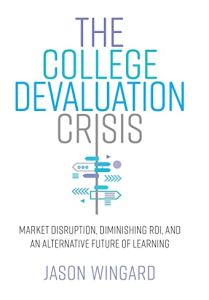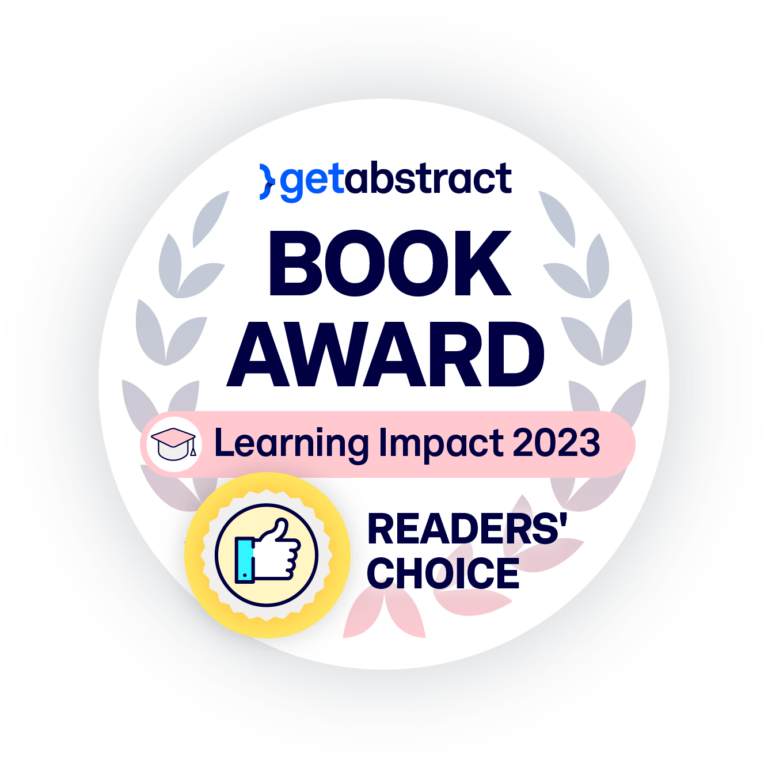Join getAbstract to access the summary!

Join getAbstract to access the summary!
Jason Wingard
The College Devaluation Crisis
Market Disruption, Diminishing ROI, and an Alternative Future of Learning
Stanford UP, 2022
What's inside?
The market value of a college degree is in decline. Understand the implications for learners, employers, educators and policymakers.
Recommendation
Learning strategist and longtime university executive Jason Wingard argues US colleges are failing to keep pace with the rapidly evolving skills landscape. Employers are seeking innovative training solutions to keep workers up to speed, as the market-based value of a traditional university degree faces precipitous decline. Wingard covers the history of higher education, outlines recent tectonic shifts in the educational landscape, and profiles emerging alternative learning models.
Take-Aways
- For more than seven decades, the college degree offered an entrée to middle-class life.
- The market-based value of a university degree peaked around 2010.
- The four-year degree no longer guarantees employment opportunities for many workers.
- Alternatives to the college degree have begun to gain traction.
- New companies and technologies help universities extend and democratize their educational offerings.
- Innovative learning organizations are working with employers to address skills gaps.
- Some learning providers aim to disrupt traditional adult education.
- Other solutions seek to bridge the divide between traditional and alternative learning models.
- Employers and educators must accelerate skills-based education and hiring.
Summary
For more than seven decades, the college degree offered an entrée to middle-class life.
Before World War II, a university education primarily provided religious training for wealthy white men. As the economy shifted from the factories and physical work of the Industrial Age toward the offices and cognitive work of the Knowledge Era, however, the college degree gained wider relevance and importance. Employers came to view achievement of a four-year degree as evidence of an ability to persevere through a rigorous selection process, heavy workloads and test performance.
College students paid significant sums for tuition and books, and sacrificed earnings to pursue their education, but their investments generally paid off. They received the so-called “good jobs” that paved their path to middle-class prosperity and job security. Indeed, even when the COVID-19 pandemic struck in 2020, college graduates suffered far fewer job losses; most simply switched from working in offices to working from home. Yet by the time COVID-19 struck, a dramatic shift in the value of a college degree was already underway.
“The debunking and subsequent devaluation of the college degree is the result of the shift to a new world of work, one requiring a different set of skills that are not attainable during four years of college and that thus must be acquired in other ways.”
As far back as 2015, polls suggested that US employers were not getting what they needed from new college graduates. At first, firms supplemented new hires’ learning with training of their own. Of late, however, companies have begun to seek employees who can contribute from day one without supplemental development.
The market-based value of a university degree peaked around 2010.
Even at its peak, work that required a college degree constituted the minority of jobs in the United States. Sometimes a college degree proves the right qualification, so long as the curriculum aligns with market needs. However, many jobs today that pay a living wage don’t require a university degree.
“By 2030, a college education and the degree that assures it will be replaced as the dominant pathway for the kind of talent development that presages professional readiness and career success.”
Since about 2008, the economy began to shift away from the Knowledge Era and the golden age of the four-year college degree. At the same time, college costs spiked, while public investment in higher education declined dramatically. College debt mounted, even as the marketability of a university degree diminished. Not surprisingly, college enrollment dropped, while corporate spending on training and talent development rose.
The four-year degree no longer guarantees employment opportunities for many workers.
In the past, prospective white-collar workers would graduate from college, enter a career and require very little formal learning beyond. Mostly privileged young people would go through the admissions process, tinker around with various courses in their first year, then select a major area of study. They would listen to qualified instructors through classroom lectures sprinkled with discussion and debate, take tests, and, if successful, earn a degree. This traditional path can still be counted on to produce graduates with valuable skills.
“Most work now requires a level of technical ability beyond the ‘I can learn and achieve a goal’ baseline the college degree was originally designed to satisfy.”
But the strengths that graduates gain from a traditional college education have become less relevant as the marketplace has changed – and the traditional model of education has other weaknesses, too. First, admissions processes still favor the economically privileged. The often outrageous cost of a university degree excludes many otherwise qualified students who can’t afford it.
More than ever, the time it takes to earn a degree often doesn’t match with what employers need. University learning is often too far detached from the applicable skills a graduate will need on the job. Thus, the degree says less to employers about whether a new hire from college can adequately perform the work.
Alternatives to the college degree have begun to gain traction.
Today’s learners cannot follow a linear path: graduate high school; go to college; earn a degree; and get a job. Over the past decade or so, more cyclical models have emerged that emphasize continuous learning. Here, you don’t start your studies at a predetermined time or place; you can enter virtually anywhere, at any time and without gatekeepers like college admissions offices.
“A college or university education may not be necessary – certainly not for everyone. Prohibitive cost for a credential that has lost its efficacy begins to sound like a senseless proposition.”
Your learning goals might arise from financial or upskilling needs. New learning opportunities could come from a formal course. But, just as likely, they consist of online tutorials or “boot camps” that offer compressed skills acquisition, such as learning an in-demand computer language. You may need to demonstrate your learning practically, and take a test. If you succeed, you’ll emerge with a certificate, a badge or other tangible credential.
Aside from time and costs, the focus on timely and relevant skills’ acquisition represents the key difference in these learning pathways. A groundswell of EdTech and other providers has emerged to offer these sorts of learning alternatives to workers and employers. But this new model requires self-reliance: Learners must stay abreast of in-demand skills and wade through a growing list of offerings. They must assess the return on investment and often pay for programs themselves.
New companies and technologies help universities extend and democratize their educational offerings.
For many, the college degree and experience remains valuable and worth the cost. College at its best teaches you the critical skill of how to think, instead of what to think. New organizations have emerged to increase the value of a degree by making it more affordable, broadening access and connecting graduates to relevant work sooner.
These include Noodle, which aids students in navigating the admissions process. It also augments students’ education with online content during their studies. Where college curriculum might prove slow to adapt to the dynamics of the market, Noodle steps in with agile programs to supplement college courses.
“No one is predicting the end of the traditional college education as a viable pathway to success in career and life.”
Practera works with colleges to provide additional experiential learning. Programs are guided by real-world needs of employers. They offer online or in-person workshops. Learning focuses on skill-building through project work. Assessments focus on workplace applicability.
Western Governors University aims to make a work-relevant, competency-based college education affordable and available to all. It targets underserved demographics, including rural residents, ethnic minorities, low-income students and first-generation college students. It offers low tuition rates, fully available online classes and self-paced studies. Its graduates report average salary increases of more than $20,000 after graduation.
Handshake helps to complete the picture by connecting new graduates with employers. Handshake’s algorithms match student’s skills with employer’s needs; its online platform enables employers to reach out to students. Handshake also provides tools for campus career centers and helps connect students with employed graduates.
Innovative learning organizations are working with employers to address skills gaps.
Today, 40% of employers complain of a skills gap between what they need and what new hires can do. ZipRecruiter aims to reduce this gap by providing a two-way marketplace and algorithms that help match workers and employers. They emphasize skills-based job descriptions and how students can best prepare to qualify for these jobs. ZipRecruiter can also refer job seekers to online learning and certifications to close skills gaps.
Degreed is similarly focused on using algorithms, in this case, to deliver the right learning at the right time. Degreed specifically aims to assist managers in coaching workers and developing their own skills. Rather than offer original educational content, Degreed curates learning opportunities from a variety of providers. The system also gives employers a complete, granular picture of in-house skills at their disposal.
Guild aims at students who want to earn their GED and move on to college. It helps prospective students choose affordable, high-quality postsecondary education and provides academic coaching. Guild also helps workers tap into employer tuition assistance benefits, and matches employer and employee learning interests.
Ernst & Young provides an example of a large firm that has partnered with education providers to offer broad access to graduate-level education. Its Tech MBA, offered through Hult International Business School, combines traditional education with experiential, on-the-job learning. Ernst & Young supports a culture of upskilling to keep employees equipped with the skills they need.
Some learning providers aim to disrupt traditional adult education.
Some learners don’t want or need a college education. Increasingly, job seekers can identify an in-demand skill, then enter rapid-learning programs to help them acquire good jobs. Google facilitates this process internally. Its low-cost Career Certificates, provided through the Coursera online learning platform, are taught by Google’s own experts. The IT Career Certificate has resulted in new jobs, pay raises or promotions for 80% of its graduates.
The nonprofit Apprenti offers apprenticeships that place workers in paid assignments, where they learn in-demand skills on the job under the guidance of an experienced professional.
“Subject-matter experts, employers, educators, policymakers and learners all deserve a seat at the table, and all must have access to available data if they are to make wise decisions about what educational resources to invest in.”
General Assembly serves both individuals and companies. Learners can enroll in short, immersive skill-accelerator programs that boost graduates’ incomes by about 35% within five years. Its longer programs can cost as much as $15,000, but they put graduates to work much sooner than college. And they allow students to pay back loans based on their salaries after graduation.
Udemy, meanwhile, offers more than 150,000 low-cost, online courses taught by some of the world’s most respected experts. Udemy helps address the shrinking “half-life” of skills: It provides workers and employers with a platform for upskilling efficiently across virtually any competency.
Other solutions seek to bridge the divide between traditional and alternative learning models.
The boom in EdTech is helping to close skills gaps but adds to the complex landscape for learners and employers. Emsi aims to furnish education providers with the labor market data they need to create the right content, and they provide employers with up-to-date skills’ taxonomies. By breaking jobs and learning into the language of skills, organizations, educators and learners can make more precise decisions about filling skills gaps.
“Human resources typically constitute the biggest expense of doing business, yet far too many companies simply don’t know what they’re buying.”
Credly aims to validate the skills workers acquire. Its Acclaim platform provides badges that confirm skills attainment from a host of partner providers. Credly aims to give employers confidence in the people they hire.
Jobs for the Future links educators, employers, philanthropists and policymakers to promote systemic change in the US educational and employment systems. The Open Skills Network connects employers, educators and tech providers to create an infrastructure that supports hiring equity and efficiency.
Employers and educators must accelerate skills-based education and hiring.
Promote learning that will serve both workers and employers by following these five research-backed priorities:
- Traditional education providers should adhere to adult learning theory, and field instructional design experts to develop and monitor curricula. They must build platforms that embed alternative learning approaches. Colleges would do well to partner with other entities to ensure their offerings remain relevant.
- Alternative education providers should create a common system for credentialing and for hard and soft skills assessment.
- Colleges and alternative education providers alike ought to aggressively reduce tuition costs and make learning more accessible.
- Employers must build cultures of continuous learning and upskilling.
- Learners need to create skills-acquisition plans and portfolios, and maintain them for life.
About the Author
Jason Wingard currently serves as chairman of the Education Board, Inc., a consultancy providing learning and strategic solutions for corporate and educational institutions. He previously worked as president of Temple University, dean of the School of Professional Studies at Columbia University, vice dean of The Wharton School, and managing director and chief learning officer at Goldman Sachs.
This document is restricted to personal use only.




















Comment on this summary